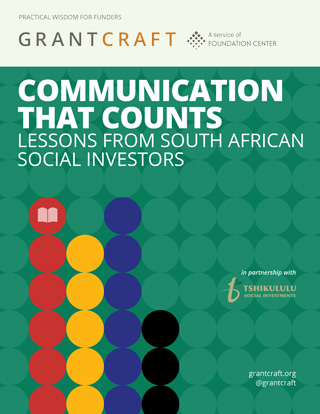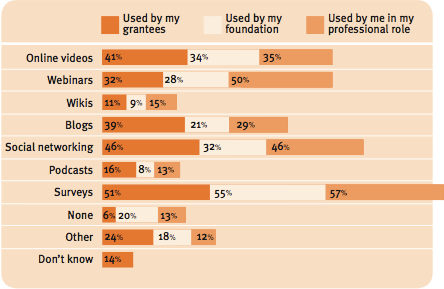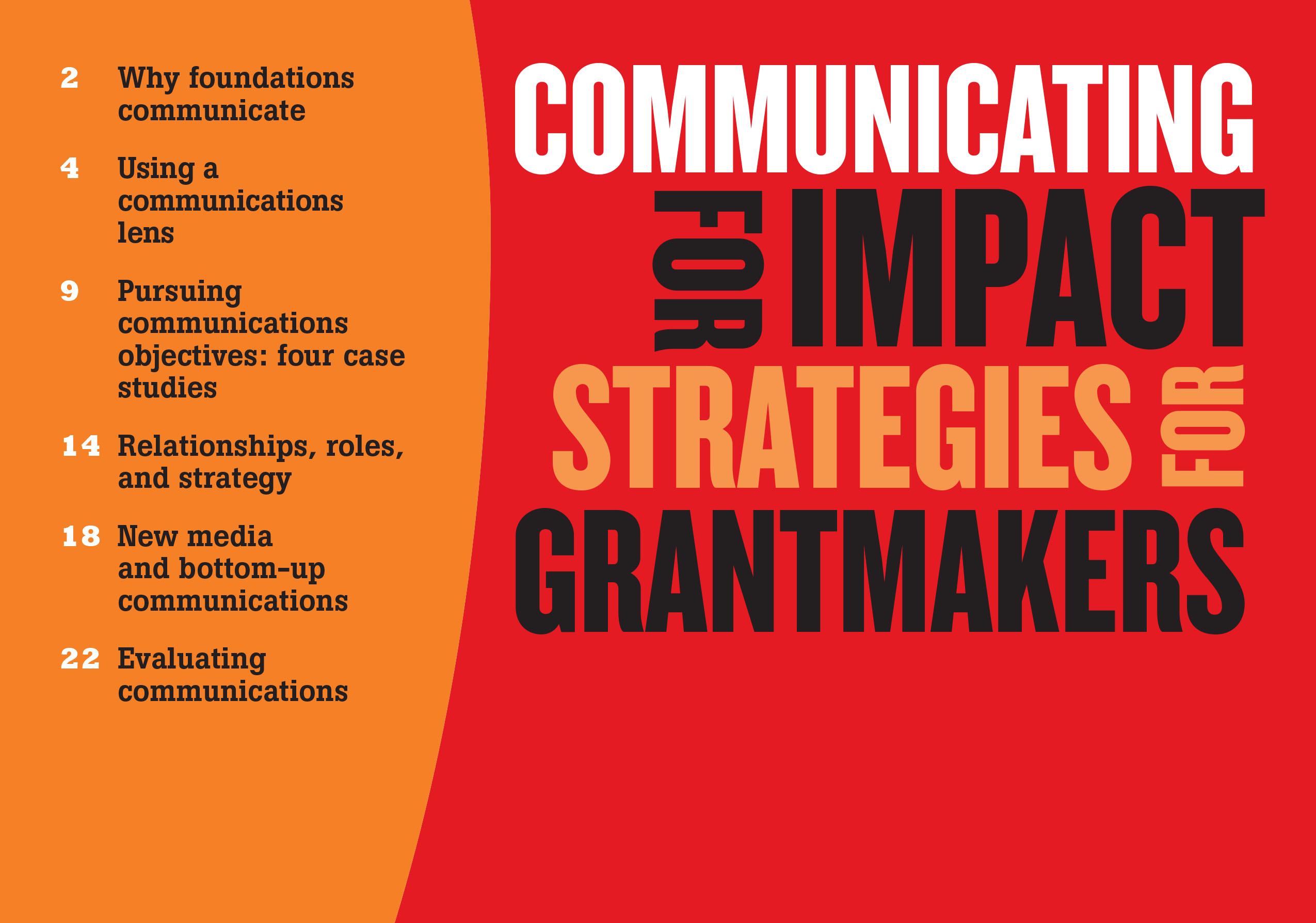Communication That Counts Lessons From South African Social Investors
Communication That Counts offers practical lessons in communicating for impact based on the experiences of funders and others involved in social investment in South Africa. The insights in Communication That Counts are pertinent both to South Africans and others beyond its borders, as it explores universal themes related to how to communicate with partners, social investors, and grantees; how to identify and achieve communication goals; and how different media can help enhance different messages. The guide was developed in partnership with Tshikululu Social Investments.
Discuss this resource and help spread the word by tweeting!
What's in the Guide?
- The South African Social Investment Landscape: In this section, we provide a brief background to South Africa and its unique social investment sector.
-
Why Communicate?: Understanding the reason for communication helps focus the particular communication needs of a social investor. We look at how to identify communication goals and offer tips for establishing a communication strategy to achieve these goals.
-
Collaboration and Enhancing Partnerships: The success of collaboration with other foundations, other programmes, and the government is significantly influenced by the way parties communicate with each other. We look at communication tools to help facilitate successful collaboration at multiple levels.
-
Grantee Communications: Social investors need to communicate regularly and effectively with grantees about things such as the availability of funding, how applications are submitted, and what is being achieved by grantees. We explore how social investors can build trust with grantees by using the right communication tools.
-
Public Relations and Brand Equity: South Africa’s corporate responsibility requirements have led to the establishment of a large number of corporate-linked foundations. We explore examples of how to balance valuable, insightful communications about social investment projects and developing corporate brand perceptions.
-
Investor Relations: In the corporate social investment space, investor relations is an important communication goal for many South African businesses. Successful investor communications require a balance between reporting stats and facts while still emphasising the real-world impact of social investment.
-
Knowledge Sharing: Communication about successes and failures can increase collaboration and extend a social investment project’s reach. We look at the different ways knowledge can be shared among donor peers.
-
Internal Communications: Aligning communication goals and strategies internally has a significant impact on the buy-in, success, and subsequent external communication of a social investment programme.
-
Monitoring and Evaluation: From communicating data about programme successes and challenges, to measuring the effectiveness of different forms of communication, monitoring and evaluation directly affects the impact of a foundation’s successful communication with its desired audience.

Categories
Content type
Strategies
Issues
-
Link to What Grantseekers Wish Grantmakers Knew About Communicating Decision
Collaboration with Government
For a number of South African grantmakers, collaborative relationships with government are particularly important. In addition to communication about work done with government, it is important to communicate clearly and effectively with relevant government stakeholders for the partnership to be effective.
Read more -
Link to What Grantseekers Wish Grantmakers Knew About Communicating Decision
Collaboration With Media/Business
Beth van Heerden, corporate social investment (CSI) executive of FirstRand Limited, says collaboration is beneficial because it allows for efficiency, instead of duplication of efforts or media fatigue around a particular initiative. As an example, she says that the FirstRand Foundation hosts three CSI that Works knowledge-sharing events annually, which bring together a variety of stakeholders around a topic of shared interest (such as early childhood development or gender-based violence). The organisation works with the Mail & Guardian newspaper as a key media partner, which publishes a report on the events. In 2014, however, the partnership developed even further as the newspaper approached FirstRand to co-host a debate on mathematics education in South Africa.
Read more -
Link to What Grantseekers Wish Grantmakers Knew About Communicating Decision
Collaborating with Funding Partners/Grantmakers
Donne Nicol, head of the Shanduka Foundation, says that collaboration is a core part of everything the organisation does, as all of its programmes are joint efforts in one way or another. For example, in March 2013, the Shanduka Foundation signed an agreement with Kagiso Trust and the Department of Education to work together in 428 schools in two districts in the Free State province. “We worked together for 18 months before the agreement was formally signed. This preparatory period and the intense communications process it involved was definitely part of the reason the partnership is successful.”
Read more -
Link to What Grantseekers Wish Grantmakers Knew About Communicating Decision
Using Communication Tools for M&E
The Tiger Brands Foundation uses mobile phone technology to communicate information about its in-school breakfast provision projects to the foundation’s head office in order to compile daily reports. In this way, real-time information is used to address issues or make improvements to the programme. Kelvin Glen notes, “We look at things like how many kids were fed, what was fed, the hygiene conditions of the cooks that are preparing the meal, the hygiene conditions of the kitchen where the meals are being prepared, and then any other factors that influence our school feeding programme, which provides healthy breakfast meals for school children.”
Read more -
Link to What Grantseekers Wish Grantmakers Knew About Communicating Decision
The Dos and Dont’s of Social Media
Social media has emerged as a valuable communication tool. It has changed the way people and communities interact with organisations and gives grantmakers access to personal, frequent, and multi-featured ways of communicating with their desired audience. We have chosen to profile this medium for communication because it is increasingly recognised as an essential counterpart to other more traditional communication channels.
Read more -
Link to What Grantseekers Wish Grantmakers Knew About Communicating Decision
Snapshots Using photography in communications
Photography helps people relate to those benefiting from funding and gives them an idea of the impact social investment work is making. Pranill Ramchander notes that while budgetary constraints might be an issue, using visual communications, whether photographic or video, boosts the efficacy of communication efforts and assists in cutting through the clutter.
Read more -
Link to What Grantseekers Wish Grantmakers Knew About Communicating Decision
Understanding the Impact of Apartheid on South African Social Investment
Although Apartheid ended 20 years ago, recovery from its systematic racial discrimination is a difficult and on-going process. Apartheid literally means “apartness” and was a system of government implemented in South Africa between 1948 and 1994 that separated people according to race in every aspect of daily life, entrenching white minority rule and discriminating against non-white population groups.
Read more -
Link to What Grantseekers Wish Grantmakers Knew About Communicating Decision
Participation as Communication Employee volunteer programmes
Employee volunteer programmes strengthen organisations’ grantmaking, build employer-employee relationships, boost staff morale, and provide a platform for employee engagement. Support from parent organisations doesn’t have to stop at finances; being involved more deeply helps donors better communicate about their work and keeps staff engaged in their social investment efforts. In doing so, multiple communication goals are achieved simultaneously
Read more -
Link to What Grantseekers Wish Grantmakers Knew About Communicating Decision
Attracting and Retaining Talent
Communication about corporate social investment (CSI) can help to attract and retain top talent. It can be an important differentiator between employers, and it can be used to ensure that employees find additional meaning and pride in their work. Effectively engaging in this space can help to equip employees to speak more knowledgeably about the company’s social investment work, both internally and externally. This creates positive brand equity, pride, and belonging amongst the staff, and ultimately impact in local communities.
Read more -
Link to What Grantseekers Wish Grantmakers Knew About Communicating Decision
Goals for Communicating in the Context of Grantmaking
The most important element of communicating in the context of grantmaking is to understand the goal for each particular communication and to tailor it accordingly. In other words, the starting point is to ask, “What are we trying to achieve?” Then social investors can ask, “Who do we need to communicate with to realise this goal?” and then, “How can we do that in a way that makes the most impact?” These questions apply to everything from large-scale public campaigns to small, one-on-one dialogues.
Read more
Communication That Counts offers practical lessons in communicating for impact based on the experiences of funders and others involved in social investment in South Africa. The insights in Communication That Counts are pertinent both to South Africans and others beyond its borders, as it explores universal themes related to how to communicate with partners, social investors, and grantees; how to identify and achieve communication goals; and how different media can help enhance different messages. The guide was developed in partnership with Tshikululu Social Investments.
Discuss this resource and help spread the word by tweeting!
What's in the Guide?
- The South African Social Investment Landscape: In this section, we provide a brief background to South Africa and its unique social investment sector.
-
Why Communicate?: Understanding the reason for communication helps focus the particular communication needs of a social investor. We look at how to identify communication goals and offer tips for establishing a communication strategy to achieve these goals.
-
Collaboration and Enhancing Partnerships: The success of collaboration with other foundations, other programmes, and the government is significantly influenced by the way parties communicate with each other. We look at communication tools to help facilitate successful collaboration at multiple levels.
-
Grantee Communications: Social investors need to communicate regularly and effectively with grantees about things such as the availability of funding, how applications are submitted, and what is being achieved by grantees. We explore how social investors can build trust with grantees by using the right communication tools.
-
Public Relations and Brand Equity: South Africa’s corporate responsibility requirements have led to the establishment of a large number of corporate-linked foundations. We explore examples of how to balance valuable, insightful communications about social investment projects and developing corporate brand perceptions.
-
Investor Relations: In the corporate social investment space, investor relations is an important communication goal for many South African businesses. Successful investor communications require a balance between reporting stats and facts while still emphasising the real-world impact of social investment.
-
Knowledge Sharing: Communication about successes and failures can increase collaboration and extend a social investment project’s reach. We look at the different ways knowledge can be shared among donor peers.
-
Internal Communications: Aligning communication goals and strategies internally has a significant impact on the buy-in, success, and subsequent external communication of a social investment programme.
-
Monitoring and Evaluation: From communicating data about programme successes and challenges, to measuring the effectiveness of different forms of communication, monitoring and evaluation directly affects the impact of a foundation’s successful communication with its desired audience.




